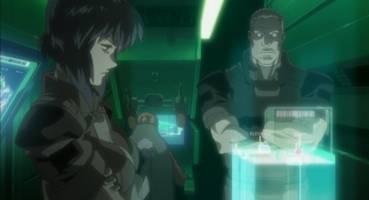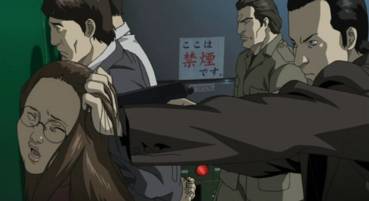"Human
are nothing but the tread from which the dream of
life is woven." |
Kim
– Ghost in the Shell 2: Innocence |
Back
in the late eighties the eccentric, strange and wonderful
Akira first introduced to my brother and
myself to Manga anime. It had an immediate impact on us
and we were hooked, wanting to see as much of this amazing
animation as possible. We started checking every week for
the new batch of Manga titles to come in, looking through
them and trying which to deciding which one to buy. My brother
started to collect series like The Guyver,
3x3 Eyes and The Crying Freeman,
which almost became an obsession. The good thing for me
was I also got to cast my critical eye over these and viewed
them for nothing; being a poor unemployed ex-student.
Manga
started to release in the UK just about every anime series
from Japan. These varied in quality and content, and they
always had a cheap look, produced quickly for an ever-increasing
niche market wanting the trademark violent content. One
of the problems I always had was the dubbing of the voices,
always over-the-top exaggerated Americans with the all the
subtle acting skill of a dead (fill in blank), and with
obvious translation issues, even adding Americanisms to
the dialog. This didn't matter to most of the target audience,
who watched these for the unusual animation and sometimes
shocking sexual and violent content. Thankfully DVD came
along and they started to produce titles with original language
soundtracks and subtitles so we could see Manga productions
close to the original form.

Ghost
in the Shell followed about nine years after Akira
as being one of the most talked about animes, thrusting
the genre back on to the worldwide stage. Pulling on various
influences from science fiction writing and films, Mamoru
Oshii combined with his own unique vision of one possible
future and created a very William Gibson-like world. with
a majority of the humans having some sort of body enhancement
connected to cyberspace. These range from implanted eyes
for help with targeting, scanning and information about
a human or cyborg, to prosthetic limbs that are faster and
stronger than normal human ones. The most extreme is a constructed
cybernetic organism total replacing the organic body leaving
only a ghost of the human sprit inside a total artificial
shell.
Following
the success of the first film, Mamoru Oshii produced a sequel
called Ghost
in the shell 2: Innocence. This was released
in 2004 to much critical acclaim and was even nominated
at Cannes. The film explored the very existence of a human
in this world he has created, how they are becoming more
than the sum of their new parts and how the fabric of consciousness
is changing.
Due
to the success of the first Ghost in the Shell
film, an anime spin off TV show was produced with high production
values and engaging story lines called Ghost in
the Shell: Stand Alone Complex. This uses the framework
set down in the first film and builds on a complex and political
world, enabling the main characters to have their own story
arcs and build up on running stories exploring this unique
world.
The
action focuses on the Section 9 Unit, consisting of Major
Motoko (the leader), who is mostly a cyborg with human soul,
Bateau, who has been enhanced to be stronger and faster
due to his various implants, Detective Togusa, the only
one who is still mostly human, and the Chief Aramaki who
deals with the political side of the group and issues the
commands and missions.
After
the success of the first season and now with an avid fan
base established, they released the start of the second
season to an expectant audience, who were hoping the series
would continue where it left off. At the end of last season
Section 9 was disbanded by the conspiracy that plagued the
last government, forcing a general election and a change
in regime.
There
are 4 episodes on these discs, they all open with a title
sequence compiled of clips from the future upcoming shows,
gelled together by a theme song, giving an intriguing glimpse
into the world populated by these characters giving a brief
insight to their lives.

In
the first episode, Reembody, the remains
of the Section 9 team are on a stake-out at a hostage situation
in the Chinese embassy. The hostages are being held by a
group called the Individual Eleven, a terrorist organization
formed to go against the 13 million people fleeing to Japan
from what was left over from World War 4 (the second Vietnam
war). They have been and are still used as a cheap labour
force to rebuild the country, and have been discarded into
refugee designated areas and left to fend for themselves.
Aramaki is trying to pull in political strings to get Section
9 reinstated, something that can only be achieved by a direct
order from the newly elected prime Minster, but she demands
the condition that not one of the hostages are harmed or
killed. The team is half way through the mission before
the local police stumble in and nearly fuck everything up,
but still manage to complete their objective and rescue
all the hostages.
As
opening episode of this series it sets up the whole future
confrontation of the refugee problem and shows the team
setting up for the hostage situation. The major's iconic
jump from the building in the first film is replicated almost
shot for shot. Very postmodern. It is fast paced with decent
action sequences, and we have a greater understanding what
Section 9 is capable of.
Night
Cruise, the second instalment on this disc, is
about a dejected cyborg war veteran pilot who is employed
to fly a personal helicopter for chairman of a large company.
He has fantasies about killing the passenger he ferries
around and saving a pleasure cyborg from harm. These violent
daydreams become more frequent the closer it gets to the
25th of December, when he will reveal the truth of what
the war was really about. We follow him through his delusions,
how they are the unappreciated fighters of an unjust war
that might have been just to keep the government in power
(hey George, this sounds familiar).
This
is Taxi Driver, Ghost in the Shell
style, even recreating the iconic mirror scene through to
rescuing the pleasure cyborg. There are many references
to the Vietnam War from a veteran's point of view, including
the integration of these ex-soldiers back into mainstream
society, the way he has been treated upon his returning
from the war and the lack of understanding of the traumas
of war, which still plague his existence. This episode is
structured differently from the first – we are following
the main protagonist all of the time, sharing his thoughts
and fears and the building of his delusional state, with
only two of the main characters, Major and Bateau, on the
fringes of the story. Exploring the world through the eyes
of potential killer is a refreshing change from the usual
narrative structure (Section 9 goes in to solve a problem
and completes mission) and gives a greater understanding
of the background of the world he lives in.
In
Cash Eye a thief calling itself The Cash
Eye breaks into a well-off government official's office
to steal the money stored there, intentionally setting off
the alarm after the break-in and leaving a calling card
for the cat burglar's next visit. It is Section 9's job
to catch this cat burglar during an upcoming party. All
is not what it seems when they arrive at the event, during
which the thief turns up as promised.
This
episode is trying to be a light-hearted, drawing on slight
influences from The Pink Panther (the thief
breaking in and leaving a calling card). It shows the government
official to be a complete sleazebag, which unfortunately
is rammed down our throats, first through his leering at
the major in her party dress, then the obvious sexual banter
between the two and the inference to his sexual promiscuity.
This suffers from the usual Manga obsession with one particular
part of the female anatomy, the breasts. I know they are
pandering to some audience expectations, but it has always
annoyed me and sometimes gets in the way of the narrative.

The
last of the episodes on this disc called Natural
Enemy. A pilot dies during a training exercise
and the AI takes over, goes nuts and starts commandeering
other unmanned helicopters from bases all over Japan, congregating
over a refugee district, turning feelings in the district
against the government. Section 9 is called in to resolve
this situation under the command of a CIS agent who directly
represents the Chief Cabinet Secretary. Again drawing on
the back-story, it introduces a new character (Goda), who
looks like he might be recurring throughout this season,
and could be the bad guy, or at least a high level lackey
for the power behind throne.
There
is an interesting political back-story that runs through
three of episodes (Reembody, Night
Cruise, Natural Enemy) that is
clearly going to be the main story arc that will run throughout
the series involving Japan's non-acceptance of Asian immigrants
using refugee status, the growing unrest festering in the
broken cities where they live and the hostility towards
this section of society from the nationalist government
and the population at large. I can't help but be a bit worried
if this is a refection of the views and altitudes of the
audience and writers on their current society.
Like
the second film it combines traditional cell animation with
computer generated ones. Unlike the animation from both
films, the quality of the animation itself is somewhat lacking.
The exception to this is the background artwork, which while
not on the same par as the films is still good enough to
enhance the look of this world.
The
discs are of high picture quality with little or no artefacting
visible. Clean bright colours and clear detailing visible
throughout. Both are presented in 16:9 anamorphic widescreen.
There
is an odd thing with these discs. The first contains the
dubbed English and Japanese languages tracks in 5.1 with
subtitles in English (hearing impaired only) with the two
interviews stated below. The second contains exactly the
same but with DTS and no interviews.
The
sound is great on both editions, but with DTS just edging
it for me because of the greater separation and slightly
crisper sound.
Disc
1 has an Interview with the director
of this series that conducted in Japanese, subtitled in
English and really boring, giving no information on how
the series was made, just going on about what will be happening
in these episodes, acting as a vocal synopsis of each of
the stories on the disc.
There
is also an Interview with the
art director and conceptual artist, in Japanese with English
subtitles. This is much more interesting, with clips for
upcoming episodes, and explanations of ideas and information
on the construction of the series.
This
series owes a lot to the success of both of the Ghost
in the Shell films, which are a must-see for anyone.
The makers have tried to draw on the rich and intriguing
world created by Mamoru Oshii and infuse the episodes with
the same spirit. Unfortunately this is an unsuccessful excursion
into his universe that misses an opportunity to increase
our appreciation of his construct. It is ultimately just
a tie-in to make money for a company that doesn't need it
and target a market place already overflowing with cheap,
mass-produced and largely unoriginal anime series.
|